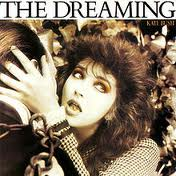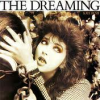 First published by L.S. Media. September 12th 2012.
First published by L.S. Media. September 12th 2012.
It might not have the distinctive feel of her earlier albums such as The Kick Inside or Never For Ever or even the later album released in 1985, the sensational Hounds of Love but The Dreamingdeserves to be recognised as album of sheer incredible artistry by the elusive Kate Bush.
The Dreaming was Kate’s fourth album and whilst it might not have the instantly recognisable stamp of music authority that she had been recording since 1975, it nonetheless has the quirky demands on the attention of the listener littered throughout the record. It was perhaps the lack of stand-out songs such as Babooshka, The Infant Kiss, Wow or Wuthering Heights that gave the album its mixed critical attention but there is something that was missed at the time which makes The Dreaming a worthy and interesting album to own as part of the collection.
Notably The Dreaming was Kate Bush’s first album that she had the pleasure to really get to grips with and produce on her own. It was a major evolution in the way that women were looked at within the music industry and it took the trail-blazing Kate Bush to do it and pave the way for others to follow in her wake. The creative freedom that was allowed to produce her own work may not have every critic or fan applauding the decision but when the songs are looked at in a new light, they don’t just sparkle, they are electric and full of themes and diversity that wouldn’t really be touched by another artist until Peter Gabriel and Tori Amos took on the mantle.
It may be a strange opening to the album but Sat In Your Lap has class written throughout it, the beginning soundscapes of drums before the introduction of Ms. Bush’s voice sets up the album perfectly. It was a strange decision though to release it as a single a full 15 months before the album was released, either a case of commercial suicide or a perfect way for Ms. Bush to keep the interest of her fans before it waned completely. Given that the song is about humanity’s pursuit of knowledge without devoting the time to explore it fully could almost be a critique of the 21st century’s fixation with the likes of Wikipedia, a chance to show what you know without really ever reading about it.
There Goes A Tenner is almost unique in the pantheon of Kate Bush tracks, not only is it regarded as single that failed, lack of radio airplay saw to that but the peculiar nature of the song didn’t appeal to many but on reflection it is alongside the title track, The Dreaming, as one of the best tracks on the album. The use of narrative, something Ms. Bush had always used so effectively in her songs is very much evident on this song. The tale of a bungled bank robbery gives perhaps Kate the opportunity to really allow herself to flow and get into the performance. The almost comical tale belies the seriousness of the song and where Kate sings it in the tone of a cockney criminal underscores the perception she is aiming for.
The song is both interesting and reminiscent of Genesis’ Robbery, Assault and Battery from Trick of The Tail and yet there is a certain darkness that is rarely mentioned. Whereas the nature of the violence is ever present in Robbery, Assault and Battery, Kate Bush plays around with it and turns it into the critique of the man committing the crime and the nightmares he has been receiving for his part. The most telling point of the song is the allusion to acting fraternity of Humphrey Bogart, George Raft and James Cagney, by placing these three actors into the narrative it gives the feel of post-war austerity and film-noir exploitation. By the end of the song and the realisation that the person on one of the notes they have stolen is someone they used to vote for gives the song the sense of purpose that the album needed.
The album revolves around the title track, The Dreaming, a song of exquisite beauty and huge political stance that it stands out as possibly one of the top five songs ever recorded by Kate Bush. As has already been noted Ms. Bush has always been at her absolute best when allowed to be her own person and have a narrative that makes the song hum with pleasure. In The Dreaming she takes the thought of narrative one stage further and puts into the voice of the Australian Aborigines community. It is a song that is fascinating to hear and leaves the listener perplexed by the image of how the Australian Government allowed the use of the native Australian’s land to be destroyed in search of weapons-grade uranium.
The song plays on the feelings of those listening to the narrative as the music eats away at any social nicety and thoughts of “well it’s so far away”. The thought of so called western civilisation raping the land of another country just to be able to blow up yet another country is perhaps one of the most chilling songs that Kate Bush ever came up with and for that she should be applauded. It is doubtful that had she not been producing the album whether the song in this form would have made it to the final master. Nervous executives would surely have cowardly pulled the plug on a track so damning in its sincerity and horror at the abuse of the Aboriginal people and their lands. For an artist as young as she was to come out with a song so politically charged stands testament to why Kate Bush is regarded as one of the best singer-songwriters of her generation and beyond.
The Dreaming may not have a Babooska, it may lack the dramatic intensity of a Wuthering Heights and it certainly lacks a Man With A Child in His Eyes but for all of that, the album is quite possibly Kate Bush’s finest moment in a long career, for it was the moment she became free.
